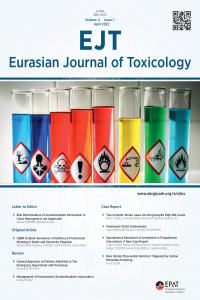ECG Changes in Patients with Amitriptyline Intoxication; P, QT, QTC, T and PR Wave Dispersion: A Retrospective Study
Dispersion; ECG; Amitriptyline; Tricyclic antidepressant; arrhythmia, Dispersion; ECG; Amitriptyline; Tricyclic antidepressant; arrhythmia, ECG; Amitriptyline; Tricyclic antidepressant; arrhythmia, ECG; Amitriptyline; Tricyclic antidepressant; arrhythmia, Amitriptyline, Tricyclic antidepressant, arrhythmia
ECG Changes in Patients with Amitriptyline Intoxication; P, QT, QTC, T and PR Wave Dispersion: A Retrospective Study
Dispersion, ECG, Amitriptyline, Tricyclic antidepressant, arrhythmia,
___
- Mowry JB, Spyker DA, Brooks DE, McMillan N, Schauben JL. 2014 annual report of the american association of poison control centers’ national poison data system (NPDS): 32nd annual report. Clinical toxicology. 2015;53(10):962-1147.
- Yildiztepe E, Aksay NH, Demir Ö, et al. Analysis of the Year 2007 Data of Dokuz Eylül University Drug and Poison Information Center, Turkey/Dokuz Eylül Üniversitesi Ilaç ve Zehir Bilgi Merkezi 2007 Yili Verilerinin Analizi. Türkiye Klinikleri Tip Bilimleri Dergisi. 2010;30(5):1622.
- Duran M, Uludag O, Yuzkat N. Analysis of adult intoxication cases treated in ICU: A sample from Adıyaman Region of Turkey. Medical Science and Discovery. 2016;3(2):71-75.
- Campleman SL, Brent J, Pizon AF, et al. Drug-specific risk of severe QT prolongation following acute drug overdose. Clinical Toxicology. 2020;58(12):1326-1334.
- Karaca O, Ertaşkın A. Epidemiology of self-poisoning with drug in the Central Anatolian Region in Turkey. Cureus. 2020;12(2).
- McClure EW, Daniels RN. Classics in Chemical Neuroscience: Amitriptyline. ACS chemical neuroscience. 2021;12(3):354- 362.
- Ozenir M, Duru NS, Elevli M, Karakus A, Civilibal M. The Familial Factors and Demographic Characteristics of Children with Drug Poisoning. Haseki Tıp Bulteni-Medical Bulletin Of Haseki. 2013;51(4):157-161.
- Manini AF, Nelson LS, Stimmel B, Vlahov D, Hoffman RS. Incidence of adverse cardiovascular events in adults following drug overdose. Academic emergency medicine. 2012;19(7):843-849.
- Manini AF, Nair AP, Vedanthan R, Vlahov D, Hoffman RS. Validation of the prognostic utility of the electrocardiogram for acute drug overdose. Journal of the American Heart Association. 2017;6(2):e004320.
- Lionte C, Bologa C, Sorodoc L. Toxic and drug-induced changes of the electrocardiogram. Advances in Electrocardiograms: Clinical Applications 1st ed Rijeka, Croatia: InTech. 2012:271-96.
- Blaber MS, Khan JN, Brebner JA, McColm R. “Lipid rescue” for tricyclic antidepressant cardiotoxicity. The Journal of emergency medicine. 2012;43(3):465-467.
- Yıldız C, Köylü R, Günaydın YK, Akıllı B, Yıldız G, Yıldırım ÖT. Evaluation of the Changes in T Peak-T End Interval and T Peak-T End/QT Ratio in Tricyclic Antidepressant Intoxication. Eurasian Journal of Toxicology. 2020;2(3):57-63.
- Hennessy S, Bilker WB, Knauss JS, et al. Cardiac arrest and ventricular arrhythmia in patients taking antipsychotic drugs: cohort study using administrative data. Bmj. 2002;325(7372):1070.
- Groleau G, Jotte R, Barish R. The electrocardiographic manifestations of cyclic antidepressant therapy and overdose: a review. The Journal of emergency medicine. 1990;8(5):597- 605.
- Avci A, Uzucek M, BugraYapici S, et al. The New Markers of Ventricular Dispersion in Patients with Acute Poisoning with TCAs: Tp-e Interval and Tp-e/QTc Ratio. Signa Vitae. 2020;1(4).
- Güloğlu C, Orak M, Üstündağ M, Altuncı YA. Analysis of amitriptyline overdose in emergency medicine. Emergency Medicine Journal. 2011;28(4):296-299.
- Buckley NA, Chevalier S, Leditschke IA, O’Connell DL, Leitch J, Pond SM. The limited utility of electrocardiography variables used to predict arrhythmia in psychotropic drug overdose. Critical Care. 2003;7(5):1-7.
- Olgun H, Yldrm ZK, Karacan M, Ceviz N. Clinical, electrocardiographic, and laboratory findings in children with amitriptyline intoxication. Pediatric emergency care. 2009;25(3):170-173.
- Caksen H, Akbayram S, Odabaş D, et al. Acute amitriptyline intoxication: an analysis of 44 children. Human & experimental toxicology. 2006;25(3):107-110.
- Dilaveris PE, Gialafos JE. P-wave dispersion: A novel predictor of paroxysmal atrial fibrillation. Annals of Noninvasive Electrocardiology. 2001;6(2):159-165.
- Bazett H. An Analysis of the Time-Relations of. Heart. 1920;7:353.
- Tse G, Yan BP. Novel arrhythmic risk markers incorporating QRS dispersion: QRSd×(T peak− T end)/QRS and QRSd×(T peak− T end)/(QT× QRS). Annals of Noninvasive Electrocardiology: the Official Journal of the International Society for Holter and Noninvasive Electrocardiology, Inc. 2017;22(6).
- Irdem A, Akpinar M, Celebi E, Aygun F, Dursun H. P-wave changes associated with Chiari network in the right atrium. Pediatric Cardiology. 2020;41(8):1773-1776.
- Okutucu S, Aytemir K, Oto A. P-wave dispersion: what we know till now? JRSM cardiovascular disease. 2016;5:2048004016639443.
- Alegría-Barrero E, Alegría-Barrero A, Gómez JJG, Juan-Aracil GR. Chiari’s network and paroxysmal atrial fibrillation. Revista Española de Cardiología (English Edition). 2011;8(64):727- 728.
- Mills KC. Tricyclic antidepressants. In Tintinalli JE, Kellen G, Stapczynski JS, editors. Emergency Medicine A Comprehensive Study Guide. 6th ed. New York: McGraw-Hill; 2004. pp. 1025-33.
- Yayın Aralığı: Yılda 3 Sayı
- Başlangıç: 2019
- Yayıncı: Acil Tıp Uzmanları Derneği
Reversible Splenial Corpus Callosum Lesion and Carbamazepine
Orhan DELİCE, Murat DAŞ, Gülhan KURTOĞLU ÇELİK, Havva ŞAHİN KAVAKLI, Salim NEŞELİOĞLU, Semra IŞIKOĞLU HATIL
Datura Zehirlenmesi ile Acile Başvuran 7 Kardeş: Kuzey Suriye’den Olgular
Bahadır KARACA, Burak ÇELİK, Murat TEPE, Buğra YILDIRIM
Alüminyum Fosfit Zehirlenmesine Bağlı Hızla Gelişen Ölüm
Pınar DEMİR GÜNDOĞMUŞ, İbrahim GÜNDOĞMUŞ, Emrah AKSAKAL
Kalsiyum Asetat Alımı Sonrası Dilde Olağandışı Aşırı Şişlik: Olgu Sunumu
